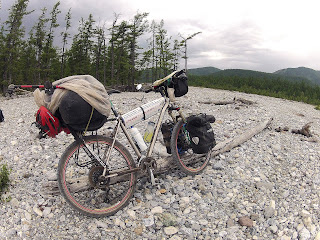MONGOLIA X2012 EXPEDITION COMPLETED IN 45 DAYS.
PHOTO SAMPLE OF THE 2499KM JOURNEY ON A MOUNTAIN BIKE.
Riding across top of the world, 45 Days in Mongolia
Writing the book currently, when completed it will contain everything I went through on the expedition, along with tips on equipment choices for long-distance, off-road endurance missions.
End of the journey, made it to the Mongolian Altai Taven-Bogd Mountain glaciers (Russia on the right, China on the left, Mongolia at the center) Peaks behind are at an altitude of 4500 meters, 14763 feet.
Live to Ride. Camp for free. Live the Dream.
Riding a LYNSKEY titanium M240S frame was definitely an awesome +++!
I rode to overcome fear, challenge myself on new terrain and inspire others to live their dreams.
Herder Shepard boy rides the final 2500th kilometer to complete the expedition at Altai Taven-Bogd National Park ranger station on the Mongolian, Russian and Chinese borders.
Baruunturuun, Mongolia on the Lynskey M240S titanium frame. Tires are 26x2.0 Schwalbe Marathon Plus Tour (1100g) with racks mounted directly to FOX Racing RL32 (120mm) front suspension forks.
Sand tracks made for a trap on 107km and 137km stretches of Mongolian steppe. National Highways in Mongolia, no rest stations/restaurants but you will meet many Nomads and visit their Gers (Yurt) for refreshing Chai (goat milk/herb tea), Bread, Butter, Cream and Mongolian dried milk curd cheese.
(remember to exchange a gift, it is a Mongolian custom).
(remember to exchange a gift, it is a Mongolian custom).
Sweet campfire over the Jiglynn Davaa (mountain pass) in Khovsgul National Park
Open roads of Mongolia, Paradise and Challenge.
I decided to step out into a new territory and try to complete a difficult expedition alone.
An idea turns into a 45-day expedition
Shaman grounds surround a forest on the western shores of Khovsgul Nuur (Lake) in the National Park
Religious location for local Nomadic Mongolian shaman
To explore, is to go beyond our comfort zones into distant lands to better see, feel, taste, touch, and communicate to understand.
Riding the Lakeshore
Stone river beds also the Jeep tracks
45kg bicycle and equipment for 45 days of expedition
Wheels by Mavic - Crossland 26" were dependable and easy to stay true.
Swimming, catching fish with a net, cooking on hot stones and collecting bleached firewood were highlights
Freedom is here in this moment, I didn't let it slip away, I lived the experience.
Camping location in the trees
After eating protein, bread and butter for two weeks, this was a real treat.
Man Vs. Fish.
The Wild Mongolia.
Another camp, another fire and photo captured using infrared filtering
Through the interior of Khovsgul, I followed the horse trails near the reindeer herding areas.
A guidebook is helpful for points on the map, and intelligence is used between to reach the next destination.
All restaurants (family Mongolian) were closed early on Saturday, this man guided me and finally had his son prepare dinner for us, it was awesome generosity and the food was amazing too.
Nomadic Mongolian herder stopped to visit, asked for water and I shared mine which was shared with me from another Nomadic family about 35km earlier in the ride that same day.
Success comes with focus, determination and daily goals for an expedition
My equipment choices were simple, recycled, and updated with the Lynskey titanium 1.3kg frame
I let many Mongolians have a ride on the bike, it was a great way to share the feeling.
I spent the summer of 2012 chasing tracks across Mongolia and learned about their culture, customs, language and amazing hospitality. A Nomadic nation that lives close to their environment and herds of animals to sustain life in a wild, undeveloped pasture and grassland with a long valley, and high mountain terrain.
45 Days in Mongolia, 2499km cycled, walked and trekked. Solo adventure with intercultural connections with Mongolian Nomads, Herders, Khalk-Mongol, Kazakh-Mongol living on the great, wild steppe, mountains, deserts of Outer Mongolia. I will have some work to do writing up the expedition this year. Updates were posted to Facebook, but the details will be released in print/PDF in 2013.
Peace from Ulaanbatar, Mongolia
Sponsor support came from LYNSKEY PERFORMANCE, USA and DONGJIN IMPORTS, KOREA

Lynskey Performance - M240S 19" titanium frame used on the Mongolia X2012.
 |
| Dongjin Sports, South Korea assisted with delivery from their inventory. |
Custom bike assembly and service provided by Ahn Dae Gi at Gangneung Bike Mart, South Korea
Educational, non-profit partner foundations I work with an an Ambassador Explorer are:
I would like to thank all my friends, family, partnering foundations and supporting sponsors for helping to make this expedition possible. Without the supportive community of sponsors, friends (donations helped tremendously -thanks again everyone! see sponsors page*) and the trust, love and support of my family this journey would would not have been successful. My spirit lives with inspiration to share with others.
Ride to freedom. I took the chance and lived the Dream this summer.
---
Difficult challenges do not defeat you, they make you stronger tomorrow
than you were today.
than you were today.
Learn to open yourself to possibilities. But be prepared to face your tests.
Build inspiration in life, when you feel full of self-doubt.
Nature and the natural world will have it's way with you.
Mark your footsteps gently while crossing over the land.
Be an inspiration of courage to others.
Always be prepared to sacrifice.
Always be prepared to sacrifice.
Face all fears ahead of you.
Try to overcome.
and
---
---
Explore!
Brian Perich
Adventure Cyclist, Explorer, Father, University Lecturer
Global Ambassador at Education Through Expeditions
Ambassador at IDEAS, Intestinal Disease Education & Awareness Society, Canada
Ambassador at IDEAS, Intestinal Disease Education & Awareness Society, Canada
Skype: prof.brian.perich
Ph. 82.10.8075.5121 (South Korea)






































